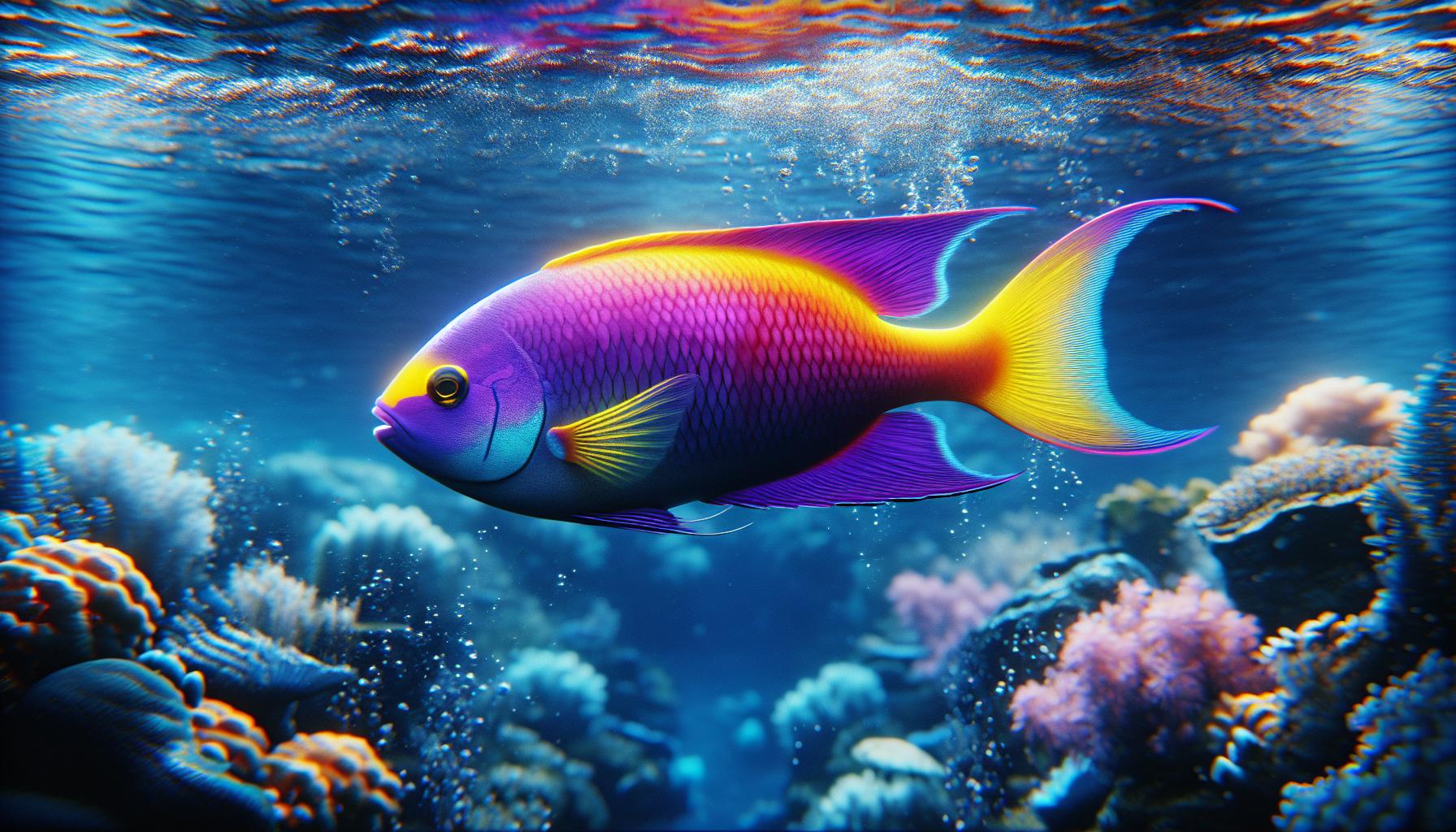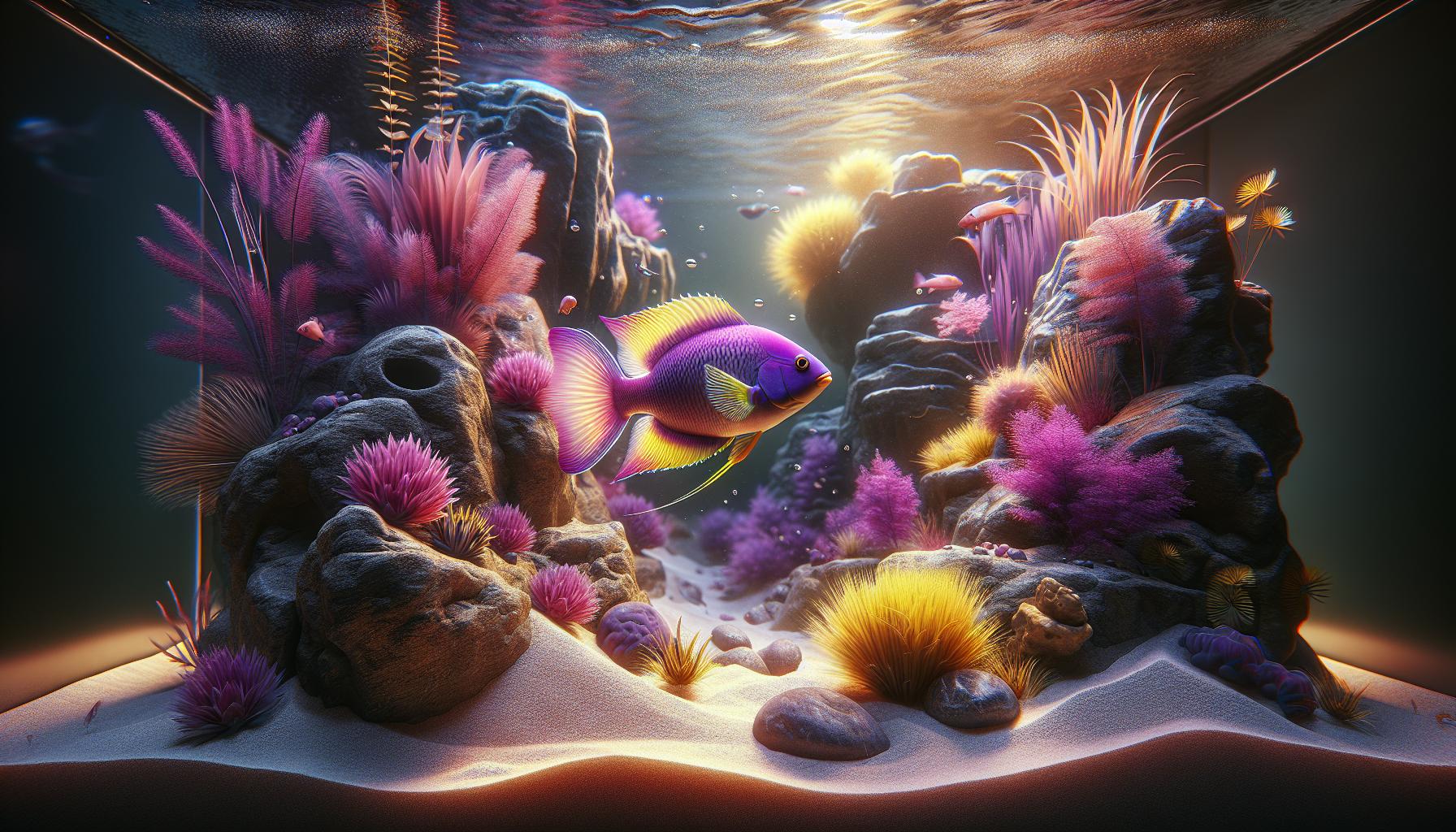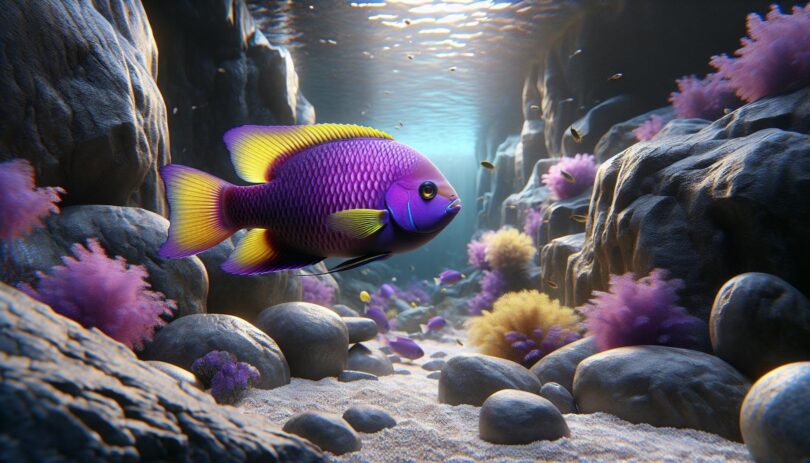Royal Gramma, a vibrant splash of color in the marine world, has always fascinated me. Known for its stunning purple and yellow hues, this fish is more than just a pretty face. It’s a staple in saltwater aquariums, beloved for its peaceful nature and ease of care.
Diving into the world of Royal Gramma, I’ve discovered they’re not only captivating to look at but also have intriguing behaviors and habitat preferences that make them stand out in the aquatic community. Whether you’re a seasoned aquarist or just starting, understanding these beautiful creatures can add a whole new level of appreciation for your underwater world.
Key Takeaways
- Royal Grammas, known for their vibrant purple and yellow hues, are native to the Caribbean Sea and the Atlantic Ocean, making them a stunning addition to saltwater aquariums due to their peaceful demeanor and ease of care.
- These fish prefer reef environments with plenty of hiding spots among rocks and coral formations, crucial for their survival and typical behavior in both their natural habitat and home aquariums.
- Proper tank conditions are essential for Royal Grammas, requiring a minimum tank size of 30 gallons, water temperatures between 72-78°F, pH levels of 8.1-8.4, specific gravity of 1.020-1.025, and incorporating live rock for natural hiding spaces.
- Royal Grammas showcase unique behaviors such as establishing territories within the tank and demonstrating vibrant colors during mating seasons; they are protogynous hermaphrodites, capable of changing sex from female to male if necessary.
- Their diet in captivity should mimic their natural predatory habits, consisting of small, meaty foods like mysis shrimp and brine shrimp, supplemented with high-quality marine flakes and pellets, fed in small amounts multiple times a day to promote health and vibrant coloration.
- Understanding and replicating the Royal Gramma’s natural environment and behaviors in a home aquarium setting can lead to a thriving, captivating marine display, enriching the aquarist’s experience and ensuring the well-being of these beautiful fish.
History and Origin of Royal Gramma

The Royal Gramma, also known scientifically as Gramma loreto, is a species I’ve always been fascinated with. Originating from the Caribbean Sea and parts of the Atlantic Ocean, this fish has garnered immense popularity in the saltwater aquarium trade. It’s not just their striking colors that captivate enthusiasts but also their rich history and origin that add an intriguing layer to their presence in our tanks.
Historically, Royal Grammas have been a significant part of the tropical reef ecosystems, contributing to the biodiversity and ecological balance. They’re often found nestled in coral reefs and rocky outcrops, making them a natural spectacle in the underwater world. My research and experiences have shown me that their preference for such habitats is not only for shelter but also plays a crucial role in their survival and breeding strategies.
The introduction of Royal Grammas into the aquarium trade can be traced back to the early 1970s. Their adaptability to aquarium life, combined with their peaceful demeanor, made them an instant hit among hobbyists. Over the years, they’ve become a staple in community tanks, proving that they can thrive in a controlled environment just as well as they do in the wild.
Understanding the history and origin of the Royal Gramma gives us a deeper appreciation of their journey from the vibrant reefs of the Caribbean to our homes. It’s a testament to their resilience and the evolving relationship between humans and marine life. As someone who keeps these magnificent creatures, I’m constantly reminded of the responsibility we have in replicating their natural habitat as closely as possible to ensure their well-being in captivity.
In exploring their past, we’re not just learning about a fish but uncovering a story that spans across decades. It’s a narrative that highlights the beauty and complexity of the natural world and our ongoing efforts to preserve it.
Physical Appearance of Royal Gramma

When I first laid eyes on a Royal Gramma, its stunning colors and unique body features immediately captivated me. This fish is a true jewel of the sea, showcasing a vibrant spectrum that’s hard to overlook in any aquarium setting. The front half of its body is a brilliant purple or violet, while the posterior is a vivid yellow or golden hue. This distinct coloration serves as more than just an aesthetic pleasure; it’s a strategic adaptation for survival in the wild, blending seamlessly with the coral reefs and rocky outcrops it calls home.
One can’t discuss the Royal Gramma without mentioning its size. Adults generally reach about 3 inches in length, making them a perfect fit for most home aquariums. Their manageable size, coupled with their peaceful nature, makes them ideal candidates for a community tank. Despite their small stature, they’re known to be quite the presence in any setup, thanks to their bold colors and curious personalities.
Their bodies are elongated and somewhat compressed, with a dorsal fin that runs almost the full length of their body. This finning, paired with their streamlined shape, allows for agile swimming and maneuvering through the intricate landscapes of their natural habitats. Observing them glide through the water, one gets a sense of their adaptability and finesse.
The Royal Gramma also boasts large, expressive eyes and a small, protruding mouth. These features aren’t just for show; they play a crucial role in their diet and social interactions within the tank. Their eyes provide them with excellent vision for spotting food and detecting potential threats, while their mouth is perfectly adapted for picking food items off of rocks and coral.
In terms of markings, juveniles often exhibit a series of vertical bars that fade as they mature into adults. This pattern change is fascinating to observe and provides insight into their growth and development. Additionally, a distinct black spot on their dorsal fin serves as a deterrent to predators, mimicking the appearance of a larger eye and giving potential threats pause before considering an attack.
Their physical attributes not only contribute to their survival but also add a lively splash of color and dynamism to any marine aquarium. Observing a Royal Gramma as it explores its surroundings, one can’t help but admire the intricacy of its design and the evolutionary craftsmanship that shaped its appearance.
Habitat and Environment for Royal Gramma
In their natural habitat, Royal Grammas thrive in the warm, clear waters of the Caribbean and Atlantic Ocean. These enchanting fish prefer reef environments where they can find ample hiding spots among the rocks and coral formations. I’ve noticed that their choice of habitat plays a crucial role in their survival, offering protection from predators and a rich hunting ground for their diet of plankton and small crustaceans.
Creating the Ideal Tank Environment
When it comes to replicating their natural habitat in a home aquarium, there are several key factors to consider to keep Royal Grammas healthy and vibrant. First, the tank size is essential. Although they’re relatively small, a minimum of 30 gallons is recommended to provide ample space for swimming and territories. Here’s a quick rundown of the ideal tank conditions:
| Factor | Ideal Condition |
|---|---|
| Water Temperature | 72-78°F |
| pH Level | 8.1-8.4 |
| Specific Gravity | 1.020-1.025 |
| Tank Size | At least 30 gallons |
Incorporating live rock in the setup not only mimics their natural reef environment but also encourages the growth of algae and microorganisms these fish can graze on. Additionally, ensuring the tank has plenty of hiding places and caves is critical for their sense of security.
Lighting and filtration are also paramount. Moderate lighting will highlight the Royal Gramma’s stunning colors, while a robust filtration system will keep the water clean and well-oxygenated, mimicking the clear waters of their natural habitat.
To sum up, creating a tank that closely resembles the Royal Gramma’s natural environment is key to their well-being. Attention to water quality, space, and the physical setup can make a significant difference. And while they’re hardy fish, maintaining stable conditions is crucial for their long-term health and colorful display in your aquarium.
Behaviors and Mating Habits of Royal Gramma
Understanding the behaviors and mating habits of Royal Gramma provides fascinating insights into their natural life cycle and helps aquarists create a conducive environment for their thriving. Known for their vibrant colors, these fish are not just eye-candy; their social and breeding behaviors are intriguing.
Royal Grammas are territorial fish. I’ve noticed that they establish their territories within the tank and defend them vigorously against intruders. This behavior is more pronounced during mating seasons. It’s essential to provide ample space and hiding spots to minimize stress among tank mates.
Their mating habits are equally captivating. Royal Grammas are protogynous hermaphrodites, meaning they have the ability to change sex from female to male. This usually happens when there’s an absence of a dominant male within the group. The largest female undergoes this transformation to become the leading male, a process that underscores the adaptability of marine life.
When it comes to breeding, these fish prefer caves or overhangs in the reef tank as their nesting spots. The male prepares the nesting site, displaying vibrant colors to attract a mate. After courtship, the female lays eggs which the male then fertilizes externally. The male’s role doesn’t end with fertilization; he guards the eggs, ensuring they’re well oxygenated and free from detritus until they hatch.
For aquarists looking to witness the breeding process, replicating the ideal tank conditions is crucial. A stable environment, with matured water conditions and plenty of hiding spots, encourages natural behaviors. It’s also important to maintain a group with a higher female to male ratio to facilitate successful breeding.
By observing these unique behaviors and understanding their mating processes, I’ve gained a deeper appreciation for Royal Grammas. Their resilience and adaptability make them not just a colorful addition to the aquarium but also a source of endless fascination.
Care and Feeding of Royal Gramma

Caring for Royal Gramma fish isn’t just about providing them a home; it’s about creating an environment where they can thrive. I’ve found that these vibrant fish need a well-structured tank to simulate their natural habitat. This includes ample rockwork and caves for hiding and territories. Lighting should be moderate, mimicking the dappled sunlight of their coral reef homes. When it comes to water parameters, stability is key. I make sure the temperature stays between 72-78°F (22-26°C), with a pH level of 8.1-8.4. I can’t stress enough the importance of maintaining these conditions for the health and happiness of Royal Gramma.
Feeding Royal Gramma is one of my favorite parts of their care. These fish are not fussy eaters, but they do require a balanced diet. I prefer a mix of meaty foods like mysis shrimp and brine shrimp, supplemented with high-quality marine flakes and pellets for a well-rounded diet. Here’s a tip: Royal Grammas are known to eat more when fed small amounts a few times a day rather than one large meal. This approach not only keeps them healthier but also mimics their natural feeding patterns.
| Water Temperature | pH Levels | Diet Recommendations |
|---|---|---|
| 72-78°F (22-26°C) | 8.1-8.4 | Mysis shrimp, brine shrimp, marine flakes, pellets |
What I find particularly interesting about Royal Grammas is their adaptive feeding behavior. In their natural habitat, they’re predators, darting out from their hiding spots to snatch up food. Replicating this in the home aquarium means providing plenty of spaces for them to ‘hunt’ their meals, adding an extra layer of engagement for these fish—and entertainment for me!
Ensuring the Royal Gramma’s diet is as varied and natural as possible not only promotes their vibrant coloration but also supports their overall health. It’s been a rewarding process to see how proper care and feeding practices bring out the best in these stunning fish.
Conclusion
Caring for Royal Grammas can be a rewarding experience if you’re up for the challenge. By setting up their tank to mirror the natural reefs they call home and sticking to the recommended water parameters, you’re laying a strong foundation for their wellbeing. Remember, their diet plays a crucial role in maintaining their vivid colors and health. So, don’t skimp on the quality of their meals. With the right care, these fish will not only thrive but also become the centerpiece of your aquarium, captivating everyone with their stunning appearance and fascinating behaviors. It’s all about creating the perfect balance in their environment and diet.
Frequently Asked Questions
What type of environment is ideal for Royal Gramma fish?
An ideal environment for Royal Gramma fish includes a well-structured tank that mimics their natural habitat with ample rockwork and caves for hiding and establishing territories. This setup helps in promoting their health and vibrant coloration.
What are the ideal water parameters for Royal Grammas?
The ideal water parameters for Royal Grammas include a temperature range of 72-78°F (22-26°C) and a pH level of 8.1-8.4. Maintaining these parameters is crucial for their well-being.
What should I feed my Royal Gramma fish?
Royal Gramma fish thrive on a balanced diet of meaty foods like mysis shrimp and brine shrimp, supplemented with high-quality marine flakes and pellets. This diet supports their vibrant coloration and overall health.
Do Royal Grammas require special feeding behaviors?
Yes, Royal Grammas exhibit adaptive feeding behavior where they dart out from hiding spots to snatch up food. It’s important to provide spaces for them to “hunt” their meals, mimicking their natural feeding habits.

